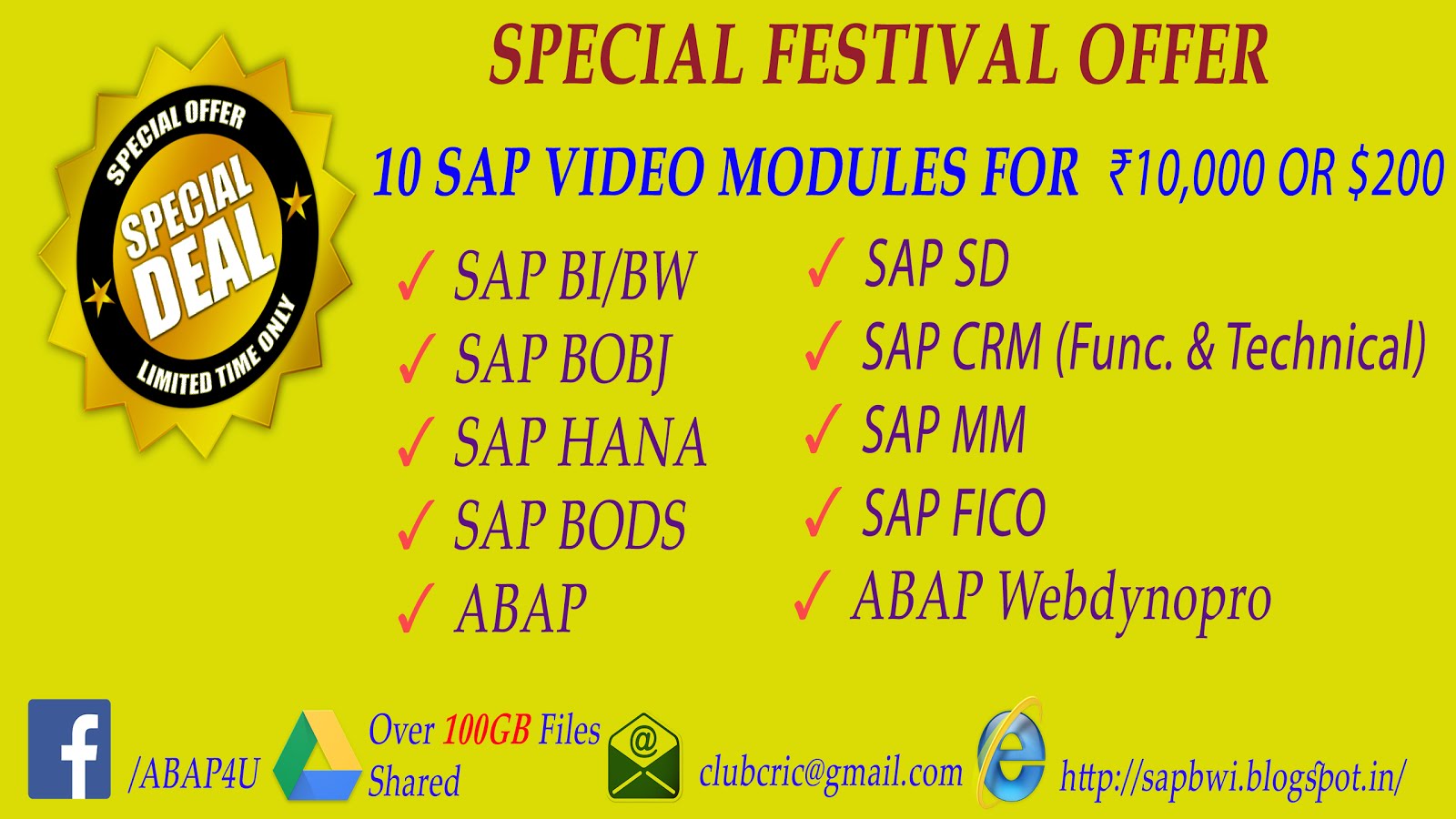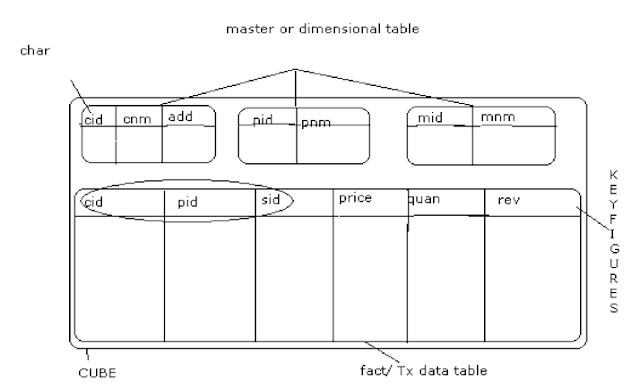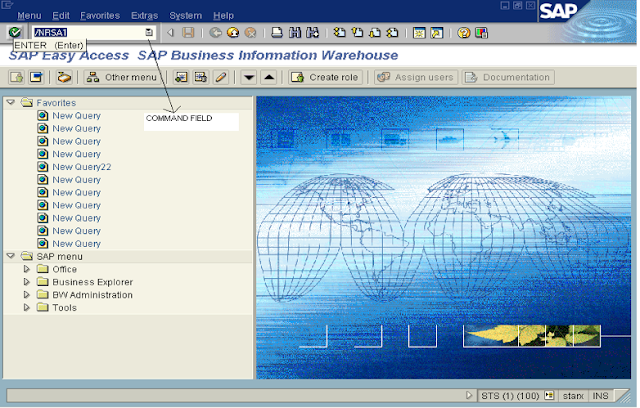BI (Business Intelligence)
Applications
are of 2 types.
1)
OLTP (Online
Transaction Processing)
2)
OLAP (Online
Analytical Processing)
Differences between OLTP and OLAP.
OLTP OLAP
1) Two dimensional
model 1) Multi dimensional
model
2) Day-to-Day
Transactions 2) Historical
data tractions also
3) Application
oriented 3) Subject
oriented
4) Users ->
Thousands 4) Users -
> Hundreds
5) DB size -> 100MB –
1GB 5) DB size -> 100GB-1TB
6) Redundancy 6) No
Redundancy
7) No security 7) Security
8) Not Integrated 8) Integrated.
Netweavers: It provides open integrity for SAP and Non SAP.
Integration is of some types
1)
People
integration
2)
Information
integration -> BI, MDM, KM.
3)
Process
integration -> XI
4)
Platform
integration
5)
Collaboration
integration -> EP
The architecture of
Netweavier is ESA. Netweaviers also a set of capabilities to provide
information/integration.
Layout/steps in SAP BW (DW):
1) DB => for
designing we can use 2 – dimensional model. Data can be stored permanently in
database.
2) Table contains rows and
columns.
i)
Each column is
a field in OLTP.
ii)
Every table
must have a Primary key.
iii)
All non-key
columns describe key columns called Attributes.
ER-Model (Entity
Relationship model):
-->
In
figure (1) and (2), CID is common. Here in figure (2) it acts as foreign key.
Designing DB:
Two ways of designing a DB.
1)
Objected
Oriented
2)
Normalization
1) Object Oriented:
- Requirements (i.e. Defining system)
- Identifying the Objects (i.e. Objects)
Ex: Customer, Material, Product etc
- Entity diagram is as follows
-->
- Attributes or Properties are nothing but properties
of a table.
- Front-end people use methods or functions only.
2) Normalization:
- Converts demoralized tables into normalized tables.
- Normalization is nothing but dividing the table
into small tables and combine them with the help of primary and foreign key
relationship.
- Demoralization contains all table data into one
table.
- Reduces redundancy of data.
- Reduce complexity
- Saves memory.
DB concepts in OLTP:
MDM (Multi Dimensional Model) is used for
designing. There are 4 types:
1)
Star Schema
(traditional schema)
2)
Extended Star
Schema (BW schema)
3)
Snow Flake
scheme
4)
Hybrid schema
1) Star Schema (traditional schema):
1)
Characters indicate
on what base you are trying to analyses.
2)
Key-figures
indicate what you are trying to analyses.
3)
Master data is
qualifying transaction data. Master data is of 3 types.
a)
Attributes
b)
Hierarchy
c)
Text
4)
Master data is
also called as Dimensional table.
5)
Star schema is
completely demoralized form.
Limitations:
1)
Since master
data is with in the fact cube so it is not reusable component.
2)
Limited
analysis because the maximum number of master data tables is 16.
3)
Performance is low because the execution of
alphanumeric data is slower than numeric data.
If we want to extract
the data from the table for example
2) Extended star schema:
-->
Extended star schema is nothing
but combination of both star schema and SID (sorigated id). Changes from star
schema to extended star schema are as follows.
- Cube is called as infocube.
- All master data tables are placed out side the cube
so they are reusable components.
- Here master data tables and Dimensional tables are
different.
When we are loading the
data into master data table then SID table is generated. Fact table contains
Dimensional ids and key figures.
- Maximum of 1 fact table per infocube.
- Any table contains maximum of 255 fields.
- Maximum of 16 Dimensional tables that an infocube
contains. 1 –unit, 1 –time, 1- packet, 13 – Dim id
- Minimum of 4 Dimensional tables that an infocube
contains. 1 –unit, 1 –time, 1- packet, 1 – Dim id.
- Maximum of 248 char per Dimensional table contains
- Maximum of 233 key figures per infocube.
Limitations:
(1)
Limiting the
no. Of joins in reporting.
(2)
Limiting no.
Of fields in Dimensional table.
Inorder to enter into the
BW Select BW 3.OB à LOGON
This is the first screen.
Give RSA1 in the command field and then press enter to login BW.
This is the first screen
for BW. It mainly contains 8 tabs.
- Modeling
- Monitoring
- Reporting Agent
- Transport Connection
- Documentation
- Business Content
- Translation
- Metadata Repository
1. Modeling:
- It mainly Contains Creating infoarea, infoobjects, infocube, infosource, infopackage, ODS, Multiprovider, datasource etc.
- Loading of all objects
- A field in OLTP is called as infoobject in BW system.
- In loading E - Extraction
T - Transferring
L - Loading
(This ETL Processing, before it is called as
ETTL – Extraction, Transferring, Transporting and Loading. But now this ETL
Processing is called as DTP – Data Transferring Process).
2. Monitoring:
·
To see weather
the load is failed or not.
·
It is a tool
with which we can schedule and execute reporting functions in the background.
4. Transport Connection:
·
By using
Transport connection we can move the objects from Development to Quality and
then to Production.
5. Documentation:
·
It enables you
to insert, search and create links for one or more documentations in various
formats, versions and languages for SAP BW Objects.
·
It contains
all the objects are delivered by SAPBW. It provides pre-Configured information
models based on metadata. It is a predefined analytical application model i.e.
part of SAP BW software.
Versions
Until unless you activate the
object, we can’t use the object.
N – NEW
M – Modified
A – Activate
D – Delivered.
Installing the business content means that
the object converted from delivered version to active version and start using
them. We can’t modify the business content objects directly. For that first
copy that object and modify it.
7. Translation:
·
Converting
from one language to another language.
·
There are 64
languages in SAP.
·
If you are
translating them, only description will be changed not technical name.
8. Meta data
Reporting:
- Data about data is called as Meta date.
- Meta data management maintains it. It is
purely in HTML format
5. Documentation:
· It enables you to insert, search and create links for one or more documentations in various formats, versions and languages for SAP BW Objects.6. Business Content:
· It contains all the objects are delivered by SAPBW. It provides pre-Configured information models based on metadata. It is a predefined analytical application model i.e. part of SAP BW software.VersionsUntil unless you activate the object, we can’t use the object.N – NEWM – ModifiedA – ActivateD – Delivered.Installing the business content means that the object converted from delivered version to active version and start using them. We can’t modify the business content objects directly. For that first copy that object and modify it.7. Translation:
· Converting from one language to another language.· There are 64 languages in SAP.· If you are translating them, only description will be changed not technical name.8. Meta data Reporting:
- Data about data is called as Meta date.
- Meta data management maintains it. It is purely in HTML format

















Your post is really good providing good information.. I liked it and enjoyed reading it.Keep sharing such important posts.
ReplyDeletesap bi training in hyderabad